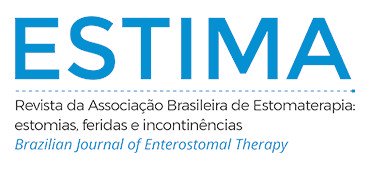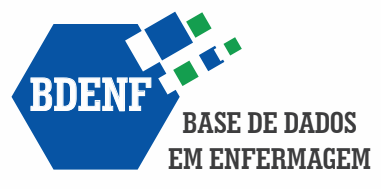Desenvolvimento de um material educativo para a prevenção e o tratamento das lesões por fricção
Resumo
Objetivo: desenvolver e validar uma cartilha educativa para ajudar o profissional da saúde a prevenir e tratar da lesão por fricção. Método: estudo metodológico. Foi realizada revisão integrativa da literatura dos periódicos publicados entre 2009 e 2019 nas principais bases de dados de Ciências da Saúde. A avaliação da cartilha educativa foi conduzida com 32 enfermeiros, utilizando a técnica de Delphi. A análise estatística utilizada foi o Índice de Validade de Conteúdo. Resultados: os juízes consideraram o conteúdo da cartilha educativa entre os conceitos “inadequado” e “adequado”, na primeira avaliação; após as correções solicitadas pelos juízes, a cartilha foi reenviada aos avaliadores e o conteúdo da cartilha educativa foi avaliado entre “adequado” e “totalmente adequado”. O Índice de Validade de Conteúdo geral foi de 0,8118 na primeira avaliação e 1,0 na segunda avaliação. Conclusão: após a revisão integrativa da literatura, o material foi construído e validado por profissionais com experiência em avaliar e tratar de indivíduos com feridas, obtendo consenso entre os avaliadores na segunda avaliação.
Downloads
Métricas
Referências
Lichterfeld-Kottner A, El Genedy M, Lahmann N, Blume- Peytavi U, Büscher A, Kottner J. Maintaining skin integrity in the aged: a systematic review. Int J Nurs Stud 2020;103:103509. https://doi.org/10.1016/j.ijnurstu.2019.103509
Rayner R, Carville K, Leslie G, Dhaliwal SS. Models for predicting skin tears: A comparison. Int Wound J. 2020 Jun;17(3):823-830. https://doi.org/10.1111/iwj.13340
Silva CVB, Camanili TCGF, Freitas NO, LeBlanc K, Baranoski S, Santos VLCG. ISTAP classification for skin tears: validation for brazilian portuguese. Int Wound J 2020;17(2):310-6. https://doi.org/10.1111/iwj.13271
Scheele CM, Göhner W, Schumann H. Cross-sectional study on skin tears in fragile, aging skin: nursing deficits in a common problem in Germany. Pflege 2020;33(3):123-32. https://doi.org/10.1024/1012-5302/a000742
Langemo DK, Williams A, Edwards K. Skin tears: prevention and management. Nursing 2019;49(4):66-9. https://doi.org/10.1097/01.NURSE.0000554309.45660.ca
Rayner R, Carville K, Leslie G, Dhaliwal SS. A risk model for prediction of skin tears in aged care residents: a prospective cohort study. Int Wound J 2019;16(1):52-63. https://doi.org/10.1111/iwj.12985
Brown A. Skin tears: Prevention and management in the elderly. J Community Nurs 2019:33(1):22-8. Disponível em: https://www.researchgate.net/publication/331839054_Skin_tears_Prevention_and_management_in_the_elderly
LeBlanc K, Campbel KE, Wood E, Beeckman D. Best practice recommendations for prevention and management of skin tears in aged skin: an overview. J Wound Ostomy Continence Nurs 2018;45(6):540-2. https://doi.org/10.1097/WON.0000000000000481
McInulty L. Prevention and management of skin tears in older people. Emerg Nurs 2017;25(3):32-9. https://doi.org/10.7748/en.2017.e1687
Catania QN, Morgan M, Martin R. Activity-Based Restorative Therapy and Skin Tears in Patients with Spinal Cord Injury. Adv Skin Wound Care 2018;31(8):371-3. https://doi.org/10.1097/01.ASW.0000534700.57785.84
Salomé GM, Cunha AL, Pereira AP, Miranda FD, Alves JR. Educational handbook for healthcare professionals: preventing complications and treating peristomal skin. J Coloproctol 2019;39(4):332-8. https://doi.org/10.1016/j.jcol.2019.07.005
Mendes B, Salomé GM, Pinheiro FAM, Júnior MRM, Cunha DR, Ferreira LM. Preventing and treating trench foot: validation of an educational manual for military personnel. J Wound Care 2018;27(Sup10):S33-8. https://doi.org/10.12968/jowc.2018.27.Sup10.S33
Mendes KDS, Silveira RCCP, Galvão CM. Revisão integrativa:método de pesquisa para a incorporação de evidências na saúde e na enfermagem. Texto Contexto Enferm 2008;17(4):758-64. http://doi.org/10.1590/S0104-07072008000400018
Santos CMC, Pimenta CAM, Nobre MRC. The Pico strategy for the research question construction and evidence search. Rev Latino-Am Enfermagem 2007;15(3):508-11. https://doi.org/10.1590/s0104-11692007000300023
Brandão ACMAG, Gambin CC; Majado CA, Kunitake N, Alexandre NMC, Dantas SRPE. Adaptação do instrumento “Perineal Assessment Tool” para a cultura brasileira. ESTIMA, Braz J Enterostomal Ther 2018;16:e0618. https://doi.org/10.30886/estima.v16.397_PT
Torres FS, Blanes L, Galvão TF, Ferreira LM. Development of a manual for the prevention and treatment of skin tears. Wounds 2018; [citado em 01 dez 2020]; 31(1):26-32. Disponível em: https://www.biosanas.com.br/uploads/outros/artigos_ cientificos/51/adc7302e06f88ce154d9b5ee99f472aa.pdf
Tristão FR, Girondi JBR, Hammerschmidt KSA, Soares CF, Martins T, Lima DKS. Risco para lesão por fricção em idosos longevos na atenção primária à saúde. ESTIMA, Braz J Enterostomal Ther 2018;16:e3218. https://doi.org/10.30886/estima.v16.614_PT
Serra R, Ielapi N, Barbetta A, Franciscis S. Skin tears and risk factors assessment: a systematic review on evidencebased medicine. Int Wound J. 2018;15(1):38-42. https://doi.org/10.1111/iwj.12815
Koyano Y, Nakagami G, Iizaka S, Sugama J, Sanada H. Skin property can predict the development of skin tears among elderly patients: a prospective cohort study. Int Wound J 2017;14(4):691-7. https://doi.org/10.1111/iwj.12675
Candeloro G. Skin tears. A quantitative study on the phenomenon and proposal for a prevention and management procedure. Ital J Wound Care 2017;1(2):61-6. https://doi.org/10.4081/ijwc.2017.13
Benbow M. Assessment, prevention and management of skin tears. Nursing Older People 2017;29(4):31-9. https://doi.org/10.7748/nop.2017.e904
LeBlanc K, Baranoski S. Skin Tears: Finally Recognized. Adv Skin Wound Care. 2017;30(2):62-63. https://doi.org/10.1097/01.ASW.0000511435.99585.0d
Normansell R, Kew KM, Mathioudakis AG. Interventions to improve inhaler technique for people with asthma. Cochrane Database Syst Rev 2017; 3(3):CD012286. https://doi.org/10.1002/14651858.CD012286.pub2
Salomé GM, Alves NF. App “SICKSEG” in mobile platform for the prevention of skin injuries. J Nurs UFPE on line 2020;14:e244152. https://doi.org/10.5205/1981-8963.2020.244152
Santos I, Brandão ES, Clós AC. Dermatology nursing: sensitive listening skills and technology for acting in skin care. Rev Enferm UERJ 2009; [citado 2019 ago 10]; 17(1):124-9. Disponível em: http://files.bvs.br/upload/S/0104-3552/2009/v17n1/a022.pdf
Carvalho MRF, Salomé GM, Ferreira LM. Construction and validation of algorithm for treatment of pressure injury. J Nurs UFPE on line 2017;11(Suppl. 10):4171-83. https://doi.org/10.5205/reuol.10712-95194-3-SM.1110sup201722
Salomé GM, Rocha CA, Miranda FD, Alves JR, Dutra RAA, Tenório AG. Algoritmos para prevenção e tratamento de dermatite associada à incontinência. ESTIMA, Braz J Enterostomal Ther 2020:e1320. https://doi.org/10.30886/estima.v18.837_IN
Downloads
Publicado
Como Citar
Edição
Seção
Licença
Copyright (c) 2020 Geraldo Magela Salomé

Este trabalho está licenciado sob uma licença Creative Commons Attribution 4.0 International License.

























